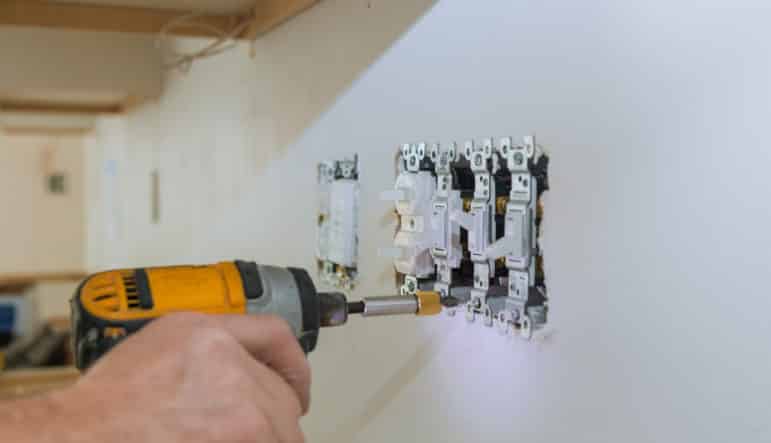Part of an electrician’s job is to manage circuits and understand their limits. For this, fundamental industry knowledge is required to ensure you don’t overload a circuit by installing too many outlets or plugging in too many devices. A basic level of maths is also helpful, since it may be necessary to do some sums with voltage and wattage.
A standard commercial circuit uses 20 amps of current, five times more than a typical residential circuit. This means there can be more outlets in a commercial building, which is useful for many businesses and service providers.
Despite this, many electricians will install the same maximum number of outlets in a commercial building as in a domestic home. This ensures the circuits aren’t overloaded by heavy machinery or high-voltage devices used in commercial premises.
Standard technical electrician skills (and safety knowledge) dictates that there should be around 12 outlets in a residential circuit, which is often the same for commercial circuits. However, some commercial circuits may have 10, and others as many as 15.
At Pro Point Electrical, all our electricians are expertly trained to provide you with the safest and best service possible. If you’re looking for a commercial electrician in Melbourne, our team is more than qualified to help.
The maximum number of outlets on a circuit will vary depending on who you speak to. As a general rule of thumb, though, there should be one outlet for every 1.5 amps of current. For residential and commercial circuits that use 20 amp circuits, there should be no more than 13 outlets. Generally, 12 is a safe number of outlets to have.
Some sources will say the maximum number of outlets can be up to 15, while others fear installing of more than 10. That’s why we take the happy medium and say 12, as we believe this is the safest option that also gets you the most out of your electricity supply.
Receptacles and outlets are two different terms for the same thing. They essentially mean any space where a device can be plugged into the power supply, and you’ll typically find them on walls in and around your home or business premises.
A 20 amp circuit is typically found in residential houses and commercial buildings and can allow up to 13 receptacles. Some electricians will install less if there are safety concerns over your devices, such as high-voltage appliances.
A 20 amp circuit is typically used in commercial premises but is also commonly found in residential homes. If we consider the rule of thumb that there should be one outlet for every 1.5 amps, the maximum number of devices for a 20 amp circuit should be around 13, but 12 is a much safer number.
A device is any electrical item or appliance plugging into a single outlet. Generally, the maximum number of devices allowed is the same as the maximum number of outlets, although this isn’t always true. The upper limit for the number of outlets should never exceed the circuit breaker’s capacity, which can increase the risk of fires and electrocution.
Calculating the number of outlets in a circuit is less technical than expected. Electricians generally rule that there should be one outlet for every 1.5 amps of current in the circuit. To calculate the maximum number of outlets, divide the total number of amps by 1.5 and round down to the nearest whole number.
For instance, a 15 amp circuit will have a maximum of 10 outlets (15 / 1.5 = 10). After we’ve rounded it down, a 20 amp circuit’s limit of outlets is 13 (20 / 1.5 = 13.33). For safety reasons, you should never round this number up.
The best tradesmen, such as master electricians, will know this off by heart and can calculate outlet capacities for even the most complex of circuits. Master electricians are the highest skilled, highest paid electricians in the trade, owing to their extensive knowledge and experience. If you’re wondering how much does a master electrician make in Australia, check out our other article from our blog.
There isn’t much difference between commercial and residential outlets regarding output. The main distinction is in the quality of the installation work. Commercial outlets are usually of higher quality than residential outlets, owing to the increased usage and need for longevity in commercial premises. The components in commercial circuits will often last a lot longer than those in a domestic home, assuming normal care conditions are followed.
If commercial outlets are of a higher quality, is commercial electric harder than residential? Despite the difference in the design quality, commercial electrical work is largely similar in difficulty to residential work. Both types of electrician are greatly skilled, just at different areas of electrical work.
Commercial circuits are similar to residential circuits in their power output and often function at 20 amps. Multiple 20-amp circuits are used in commercial premises to ensure every machine, device, and appliance functions without overloading the building’s electricity supply.
If you’re looking for highly skilled, fully qualified commercial electricians, our team at Pro Point Electrical can help. Our extensively trained electricians are experts in their trade so that we can guarantee you the highest quality service.
Call us today on 0401 757 325 or contact us online via our website, and we’ll organise the commercial electrical help you need.

